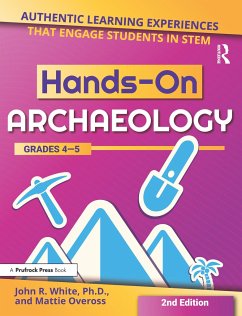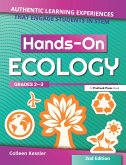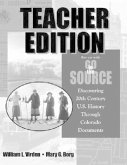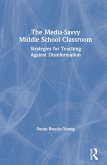John R White, Mattie Oveross
Hands-On Archaeology
Authentic Learning Experiences That Engage Students in Stem (Grades 4-5)
John R White, Mattie Oveross
Hands-On Archaeology
Authentic Learning Experiences That Engage Students in Stem (Grades 4-5)
- Broschiertes Buch
- Merkliste
- Auf die Merkliste
- Bewerten Bewerten
- Teilen
- Produkt teilen
- Produkterinnerung
- Produkterinnerung
Hands-On Archaeology immerses students in the world of real-life archaeologists. Through engaging authentic learning experiences, students will discover artifacts from the past and participate in archaeological digs while building STEM skills, as well as making connections to geography, history, art, and English language arts.
Andere Kunden interessierten sich auch für
![Hands-On Ecology Hands-On Ecology]() Colleen KesslerHands-On Ecology27,99 €
Colleen KesslerHands-On Ecology27,99 €![Go to the Source Go to the Source]() William L VirdenGo to the Source19,99 €
William L VirdenGo to the Source19,99 €![It's Not What You Teach But How It's Not What You Teach But How]() Nancy SullaIt's Not What You Teach But How126,99 €
Nancy SullaIt's Not What You Teach But How126,99 €![Using Children's Literature to Teach Problem Solving in Math Using Children's Literature to Teach Problem Solving in Math]() Jeanne WhiteUsing Children's Literature to Teach Problem Solving in Math37,99 €
Jeanne WhiteUsing Children's Literature to Teach Problem Solving in Math37,99 €![The Media-Savvy Middle School Classroom The Media-Savvy Middle School Classroom]() Susan Brooks-YoungThe Media-Savvy Middle School Classroom159,99 €
Susan Brooks-YoungThe Media-Savvy Middle School Classroom159,99 €![Beyond the Classroom Beyond the Classroom]() Beyond the Classroom154,99 €
Beyond the Classroom154,99 €![The First-Year English Teacher's Guidebook The First-Year English Teacher's Guidebook]() Sean RudayThe First-Year English Teacher's Guidebook132,99 €
Sean RudayThe First-Year English Teacher's Guidebook132,99 €-
-
Hands-On Archaeology immerses students in the world of real-life archaeologists. Through engaging authentic learning experiences, students will discover artifacts from the past and participate in archaeological digs while building STEM skills, as well as making connections to geography, history, art, and English language arts.
Hinweis: Dieser Artikel kann nur an eine deutsche Lieferadresse ausgeliefert werden.
Hinweis: Dieser Artikel kann nur an eine deutsche Lieferadresse ausgeliefert werden.
Produktdetails
- Produktdetails
- Verlag: Taylor & Francis Ltd (Sales)
- 2nd edition
- Seitenzahl: 212
- Erscheinungstermin: 15. Juni 2019
- Englisch
- Abmessung: 277mm x 213mm x 15mm
- Gewicht: 522g
- ISBN-13: 9781618218513
- ISBN-10: 1618218514
- Artikelnr.: 54921316
- Herstellerkennzeichnung
- Libri GmbH
- Europaallee 1
- 36244 Bad Hersfeld
- gpsr@libri.de
- Verlag: Taylor & Francis Ltd (Sales)
- 2nd edition
- Seitenzahl: 212
- Erscheinungstermin: 15. Juni 2019
- Englisch
- Abmessung: 277mm x 213mm x 15mm
- Gewicht: 522g
- ISBN-13: 9781618218513
- ISBN-10: 1618218514
- Artikelnr.: 54921316
- Herstellerkennzeichnung
- Libri GmbH
- Europaallee 1
- 36244 Bad Hersfeld
- gpsr@libri.de
John White has been a professor of anthropology and archaeology for more than 35 years. Presently the chair of the department at Youngstown State University, Dr. White is actively involved in field research covering a wide range of interests. His research has resulted in the publication of more than 200 scholarly articles, reports, monographs, and books on various subjects ranging from archaeological method and theory to Native American civil rights and Ohio and Oregon prehistory, early ironmaking, archaeoastronomy, and industrial archaeology. He is the local forensic anthropologist and along with his students is involved in local crime scene investigations. He has been awarded six research professorships and on five occasions has been voted Distinguished Professor. Since 1980, he has been involved in archaeology as a teaching tool in elementary and secondary schools. It was this latter interest that led to the writing of this book for teachers. He presently is working on a book on forensic anthropology for students in grades 6-12. He enjoys acting-he has been in more than 25 plays-and sitting on his deck with a good book and a pair of binoculars for bird watching. Mattie Oveross is a doctoral student at the University of North Texas pursuing a Ph.D. in Educational Psychology with a concentration in Gifted and Talented Education. She is also the curriculum director at a private school that serves gifted and talented students.
Introduction Part 1: Introduction to Archaeology Chapter 1: Getting Started
Activity 1.1: Archaeologist by Day Activity 1.2: Building an Archaeology
Kit Activity 1.3: Making an Excavator's Scoop Activity 1.4: Keeping a
Journal Activity 1.5: Site in a Bag Activity 1.6: What in the World?
Activity 1.7: Shape and Material Equals Function Activity 1.8: Wastebasket
Archaeology Chapter 2: Using the Scientific Method and Recording Data
Activity 2.1: What Do You See? Activity 2.2: Forming and Testing Hypotheses
Activity 2.3: Designing a Recording Form Activity 2.4: Filling Out Forms
Part 2: Preparing for Fieldwork Chapter 3: Pre-Excavation Research Activity
3.1: Measuring Distance on Maps Activity 3.2: Map Reading Activity 3.3:
Learning UTM Activity 3.4: Measuring UTM Distances Activity 3.5: Who Lived
There? Chapter 4: Laying Out the Site Activity 4.1: The Classroom as Site
Activity 4.2: Gridding a Site (Arbitrary Units) Activity 4.3: Gridding a
Site (Nonarbitrary Units) Part 3: The Dig Chapter 5: Excavation Activity
5.1: Excavation Techniques Activity 5.2: Playground Pick-Up (Phase I)
Activity 5.3: Playground Pick-Up (Phase II) Activity 5.4: Tabletop
Archaeology Activity 5.5: Labeling Unit Bags Chapter 6: Maintaining Field
Records Activity 6.1: Recording the Throwaways Activity 6.2: Recording
Features Activity 6.3: Recording Artifacts Activity 6.4: Informative
Photography Activity 6.5: Completing a Photo Log Chapter 7: Cataloguing and
Maintaining a Repository Activity 7.1: The Accession Log Activity 7.2: Pot
Repair Activity 7.3: Labeling Artifacts Activity 7.4: Separating the
Artifacts Activity 7.5: Building a Repository Activity 7.6: Repository
Opening Ceremony Part 4: Post-Excavation Chapter 8: Producing a Site Report
Activity 8.1: Setting Up a Site Report Chapter 9: Creating a Museum Display
Activity 9.1: Building a Diorama Activity 9.2: Building an Interpretive
Exhibit Activity 9.3: Advertising an Event Activity 9.4: Prepare a Press
Release Chapter 10: Taking the Show on the Road Activity 10.1: A Suitcase
Museum Activity 10.2: TV News Show Appendix A: Additional Archaeology
Resources Appendix B: Archaeological Forms Appendix C: Letters of
Communication About the Authors Common Core State Standards Alignment Next
Generation Science Standards Alignment
Activity 1.1: Archaeologist by Day Activity 1.2: Building an Archaeology
Kit Activity 1.3: Making an Excavator's Scoop Activity 1.4: Keeping a
Journal Activity 1.5: Site in a Bag Activity 1.6: What in the World?
Activity 1.7: Shape and Material Equals Function Activity 1.8: Wastebasket
Archaeology Chapter 2: Using the Scientific Method and Recording Data
Activity 2.1: What Do You See? Activity 2.2: Forming and Testing Hypotheses
Activity 2.3: Designing a Recording Form Activity 2.4: Filling Out Forms
Part 2: Preparing for Fieldwork Chapter 3: Pre-Excavation Research Activity
3.1: Measuring Distance on Maps Activity 3.2: Map Reading Activity 3.3:
Learning UTM Activity 3.4: Measuring UTM Distances Activity 3.5: Who Lived
There? Chapter 4: Laying Out the Site Activity 4.1: The Classroom as Site
Activity 4.2: Gridding a Site (Arbitrary Units) Activity 4.3: Gridding a
Site (Nonarbitrary Units) Part 3: The Dig Chapter 5: Excavation Activity
5.1: Excavation Techniques Activity 5.2: Playground Pick-Up (Phase I)
Activity 5.3: Playground Pick-Up (Phase II) Activity 5.4: Tabletop
Archaeology Activity 5.5: Labeling Unit Bags Chapter 6: Maintaining Field
Records Activity 6.1: Recording the Throwaways Activity 6.2: Recording
Features Activity 6.3: Recording Artifacts Activity 6.4: Informative
Photography Activity 6.5: Completing a Photo Log Chapter 7: Cataloguing and
Maintaining a Repository Activity 7.1: The Accession Log Activity 7.2: Pot
Repair Activity 7.3: Labeling Artifacts Activity 7.4: Separating the
Artifacts Activity 7.5: Building a Repository Activity 7.6: Repository
Opening Ceremony Part 4: Post-Excavation Chapter 8: Producing a Site Report
Activity 8.1: Setting Up a Site Report Chapter 9: Creating a Museum Display
Activity 9.1: Building a Diorama Activity 9.2: Building an Interpretive
Exhibit Activity 9.3: Advertising an Event Activity 9.4: Prepare a Press
Release Chapter 10: Taking the Show on the Road Activity 10.1: A Suitcase
Museum Activity 10.2: TV News Show Appendix A: Additional Archaeology
Resources Appendix B: Archaeological Forms Appendix C: Letters of
Communication About the Authors Common Core State Standards Alignment Next
Generation Science Standards Alignment
Introduction Part 1: Introduction to Archaeology Chapter 1: Getting Started
Activity 1.1: Archaeologist by Day Activity 1.2: Building an Archaeology
Kit Activity 1.3: Making an Excavator's Scoop Activity 1.4: Keeping a
Journal Activity 1.5: Site in a Bag Activity 1.6: What in the World?
Activity 1.7: Shape and Material Equals Function Activity 1.8: Wastebasket
Archaeology Chapter 2: Using the Scientific Method and Recording Data
Activity 2.1: What Do You See? Activity 2.2: Forming and Testing Hypotheses
Activity 2.3: Designing a Recording Form Activity 2.4: Filling Out Forms
Part 2: Preparing for Fieldwork Chapter 3: Pre-Excavation Research Activity
3.1: Measuring Distance on Maps Activity 3.2: Map Reading Activity 3.3:
Learning UTM Activity 3.4: Measuring UTM Distances Activity 3.5: Who Lived
There? Chapter 4: Laying Out the Site Activity 4.1: The Classroom as Site
Activity 4.2: Gridding a Site (Arbitrary Units) Activity 4.3: Gridding a
Site (Nonarbitrary Units) Part 3: The Dig Chapter 5: Excavation Activity
5.1: Excavation Techniques Activity 5.2: Playground Pick-Up (Phase I)
Activity 5.3: Playground Pick-Up (Phase II) Activity 5.4: Tabletop
Archaeology Activity 5.5: Labeling Unit Bags Chapter 6: Maintaining Field
Records Activity 6.1: Recording the Throwaways Activity 6.2: Recording
Features Activity 6.3: Recording Artifacts Activity 6.4: Informative
Photography Activity 6.5: Completing a Photo Log Chapter 7: Cataloguing and
Maintaining a Repository Activity 7.1: The Accession Log Activity 7.2: Pot
Repair Activity 7.3: Labeling Artifacts Activity 7.4: Separating the
Artifacts Activity 7.5: Building a Repository Activity 7.6: Repository
Opening Ceremony Part 4: Post-Excavation Chapter 8: Producing a Site Report
Activity 8.1: Setting Up a Site Report Chapter 9: Creating a Museum Display
Activity 9.1: Building a Diorama Activity 9.2: Building an Interpretive
Exhibit Activity 9.3: Advertising an Event Activity 9.4: Prepare a Press
Release Chapter 10: Taking the Show on the Road Activity 10.1: A Suitcase
Museum Activity 10.2: TV News Show Appendix A: Additional Archaeology
Resources Appendix B: Archaeological Forms Appendix C: Letters of
Communication About the Authors Common Core State Standards Alignment Next
Generation Science Standards Alignment
Activity 1.1: Archaeologist by Day Activity 1.2: Building an Archaeology
Kit Activity 1.3: Making an Excavator's Scoop Activity 1.4: Keeping a
Journal Activity 1.5: Site in a Bag Activity 1.6: What in the World?
Activity 1.7: Shape and Material Equals Function Activity 1.8: Wastebasket
Archaeology Chapter 2: Using the Scientific Method and Recording Data
Activity 2.1: What Do You See? Activity 2.2: Forming and Testing Hypotheses
Activity 2.3: Designing a Recording Form Activity 2.4: Filling Out Forms
Part 2: Preparing for Fieldwork Chapter 3: Pre-Excavation Research Activity
3.1: Measuring Distance on Maps Activity 3.2: Map Reading Activity 3.3:
Learning UTM Activity 3.4: Measuring UTM Distances Activity 3.5: Who Lived
There? Chapter 4: Laying Out the Site Activity 4.1: The Classroom as Site
Activity 4.2: Gridding a Site (Arbitrary Units) Activity 4.3: Gridding a
Site (Nonarbitrary Units) Part 3: The Dig Chapter 5: Excavation Activity
5.1: Excavation Techniques Activity 5.2: Playground Pick-Up (Phase I)
Activity 5.3: Playground Pick-Up (Phase II) Activity 5.4: Tabletop
Archaeology Activity 5.5: Labeling Unit Bags Chapter 6: Maintaining Field
Records Activity 6.1: Recording the Throwaways Activity 6.2: Recording
Features Activity 6.3: Recording Artifacts Activity 6.4: Informative
Photography Activity 6.5: Completing a Photo Log Chapter 7: Cataloguing and
Maintaining a Repository Activity 7.1: The Accession Log Activity 7.2: Pot
Repair Activity 7.3: Labeling Artifacts Activity 7.4: Separating the
Artifacts Activity 7.5: Building a Repository Activity 7.6: Repository
Opening Ceremony Part 4: Post-Excavation Chapter 8: Producing a Site Report
Activity 8.1: Setting Up a Site Report Chapter 9: Creating a Museum Display
Activity 9.1: Building a Diorama Activity 9.2: Building an Interpretive
Exhibit Activity 9.3: Advertising an Event Activity 9.4: Prepare a Press
Release Chapter 10: Taking the Show on the Road Activity 10.1: A Suitcase
Museum Activity 10.2: TV News Show Appendix A: Additional Archaeology
Resources Appendix B: Archaeological Forms Appendix C: Letters of
Communication About the Authors Common Core State Standards Alignment Next
Generation Science Standards Alignment








